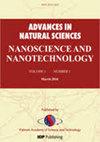利用Ag/ZnO异质结对偶氮染料进行LED可见光催化净化
IF 2.1
Q3 MATERIALS SCIENCE, MULTIDISCIPLINARY
Advances in Natural Sciences: Nanoscience and Nanotechnology
Pub Date : 2023-09-01
DOI:10.1088/2043-6262/acf2ee
引用次数: 0
摘要
Ag/ZnO异质结光催化剂在可见光下分解废水中偶氮染料的前景是一项新兴的研究。本文以松香为原料,采用绿色化学方法合成了粒径为20 ~ 50 nm的Ag/ZnO球形纳米颗粒。Ag纳米粒子(NPs)与ZnO纳米粒子的结合通过Ag纳米粒子表面等离子体共振(SPR)在450 ~ 500 nm波长范围内扩展了光活性范围。结果表明,在LED灯照射6 h后,Ag/ZnO对MO和苯酚的可见光降解率分别为80.92%和44.15%。经过三次光催化实验,Ag/ZnO的稳定性达到了60%左右。本文章由计算机程序翻译,如有差异,请以英文原文为准。
A LED visible-light-driven photocatalytic decontamination of azo dyes using Ag/ZnO heterojunction
An emerging study is an Ag/ZnO heterojunction photocatalyst for the decomposition prospect of azo dyes in wastewater under visible light. Herein, spherical nanoparticles of the Ag/ZnO of 20–50 nm are synthesised via a green chemical method from a rosin agent. Combining Ag nanoparticles (NPs) and ZnO NPs extended the photoactivity range via a surface plasmon resonance (SPR) of Ag NPs at a wavelength of 450–500 nm region. Consequently, the visible light photocatalytic degradation performance of Ag/ZnO for MO and phenol removal is 80.92% and 44.15%, respectively after 6 h of LED lamp illumination. The high stability of the Ag/ZnO is achieved by approximately 60% after three times of the photocatalytic test.
求助全文
通过发布文献求助,成功后即可免费获取论文全文。
去求助
来源期刊

Advances in Natural Sciences: Nanoscience and Nanotechnology
NANOSCIENCE & NANOTECHNOLOGYMATERIALS SCIE-MATERIALS SCIENCE, MULTIDISCIPLINARY
自引率
4.80%
发文量
0
 求助内容:
求助内容: 应助结果提醒方式:
应助结果提醒方式:


